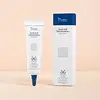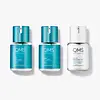What's inside
What's inside
 Key Ingredients
Key Ingredients

 Benefits
Benefits

 Concerns
Concerns

 Ingredients Side-by-side
Ingredients Side-by-side

Water
Skin ConditioningZinc Oxide
Cosmetic ColorantSulfur
AntiseborrhoeicGlycerin
HumectantCaprylic/Capric Triglyceride
MaskingPentylene Glycol
Skin ConditioningCetearyl Alcohol
EmollientTranexamic Acid
AstringentSqualane
EmollientAlpha-Arbutin
AntioxidantSalicylic Acid
MaskingDisodium Cetearyl Sulfosuccinate
CleansingUrea
BufferingAcacia Senegal Gum
MaskingSilica
AbrasiveBeta-Glucan
Skin ConditioningGlycyrrhiza Glabra Root Extract
BleachingSodium Lactate
BufferingButyrospermum Parkii Butter
Skin ConditioningPanthenol
Skin ConditioningTocopherol
AntioxidantHelianthus Annuus Seed Oil
EmollientCitric Acid
BufferingSodium Hyaluronate
HumectantAgar
MaskingPectin
Emulsion StabilisingWater, Zinc Oxide, Sulfur, Glycerin, Caprylic/Capric Triglyceride, Pentylene Glycol, Cetearyl Alcohol, Tranexamic Acid, Squalane, Alpha-Arbutin, Salicylic Acid, Disodium Cetearyl Sulfosuccinate, Urea, Acacia Senegal Gum, Silica, Beta-Glucan, Glycyrrhiza Glabra Root Extract, Sodium Lactate, Butyrospermum Parkii Butter, Panthenol, Tocopherol, Helianthus Annuus Seed Oil, Citric Acid, Sodium Hyaluronate, Agar, Pectin
Glycerin
HumectantPropylene Glycol
HumectantPentylene Glycol
Skin ConditioningPolyglyceryl-4 Caprate
EmulsifyingAtelocollagen
Skin ConditioningSodium Hyaluronate
HumectantEperua Falcata Bark Extract
Skin ProtectingWhey Protein
Skin ConditioningPanthenol
Skin ConditioningHydrolyzed Soy Protein
HumectantBis(Tripeptide-1) Copper Acetate
Skin ConditioningGlycoproteins
Skin ConditioningCaprylyl Glycol
EmollientMaltodextrin
AbsorbentXanthan Gum
EmulsifyingPhenoxyethanol
PreservativeCarrageenan
Citric Acid
BufferingDipropylene Glycol
HumectantButylene Glycol
HumectantGlyceryl Caprylate
EmollientBisabolol
MaskingTetrasodium Glutamate Diacetate
Caramel
Cosmetic ColorantArginine
MaskingSodium Lactate
BufferingHexyl Cinnamal
PerfumingPhospholipids
Skin ConditioningGlycine
BufferingProline
Skin ConditioningSorbitol
HumectantCarbomer
Emulsion StabilisingCoco-Glucoside
CleansingGlutamic Acid
HumectantLinalool
PerfumingBenzyl Benzoate
AntimicrobialSodium Hydroxide
BufferingParfum
MaskingLactose
HumectantEthylhexylglycerin
Skin ConditioningSodium Citrate
BufferingThreonine
Valine
MaskingSodium Dehydroacetate
PreservativePalmitoyl Tripeptide-1
Skin ConditioningSodium Metabisulfite
AntioxidantAloe Barbadensis Leaf Juice
Skin ConditioningTocopheryl Acetate
AntioxidantSodium Phytate
Potassium Sorbate
PreservativeSodium Benzoate
MaskingDipotassium Phosphate
BufferingAlcohol
AntimicrobialPalmitoyl Tetrapeptide-7
Skin ConditioningGlycolic Acid
BufferingLactic Acid
BufferingC12-15 Pareth-12
EmulsifyingMalic Acid
BufferingTartaric Acid
BufferingLactobacillus
Skin ConditioningBacillus Ferment
Skin ConditioningMel
EmollientTocopherol
AntioxidantHyaluronic Acid
HumectantGlycine Soja Protein
EmulsifyingLecithin
EmollientSalix Alba Bark Extract
AstringentSphingolipids
EmollientDehydroacetic Acid
PreservativeAllantoin
Skin ConditioningStyrene/Vp Copolymer
Disodium EDTA
Calcium Chloride
AstringentPotassium Phosphate
BufferingAlpha-Isomethyl Ionone
PerfumingLimonene
PerfumingButylphenyl Methylpropional
PerfumingBenzyl Salicylate
PerfumingSodium Laureth-40 Sulfate
CleansingCoumarin
PerfumingCitronellol
PerfumingSorbic Acid
PreservativeSodium Chloride
MaskingSodium Sulfate
CI 47005
Cosmetic ColorantCI 42090
Cosmetic ColorantGlycerin, Propylene Glycol, Pentylene Glycol, Polyglyceryl-4 Caprate, Atelocollagen, Sodium Hyaluronate, Eperua Falcata Bark Extract, Whey Protein, Panthenol, Hydrolyzed Soy Protein, Bis(Tripeptide-1) Copper Acetate, Glycoproteins, Caprylyl Glycol, Maltodextrin, Xanthan Gum, Phenoxyethanol, Carrageenan, Citric Acid, Dipropylene Glycol, Butylene Glycol, Glyceryl Caprylate, Bisabolol, Tetrasodium Glutamate Diacetate, Caramel, Arginine, Sodium Lactate, Hexyl Cinnamal, Phospholipids, Glycine, Proline, Sorbitol, Carbomer, Coco-Glucoside, Glutamic Acid, Linalool, Benzyl Benzoate, Sodium Hydroxide, Parfum, Lactose, Ethylhexylglycerin, Sodium Citrate, Threonine, Valine, Sodium Dehydroacetate, Palmitoyl Tripeptide-1, Sodium Metabisulfite, Aloe Barbadensis Leaf Juice, Tocopheryl Acetate, Sodium Phytate, Potassium Sorbate, Sodium Benzoate, Dipotassium Phosphate, Alcohol, Palmitoyl Tetrapeptide-7, Glycolic Acid, Lactic Acid, C12-15 Pareth-12, Malic Acid, Tartaric Acid, Lactobacillus, Bacillus Ferment, Mel, Tocopherol, Hyaluronic Acid, Glycine Soja Protein, Lecithin, Salix Alba Bark Extract, Sphingolipids, Dehydroacetic Acid, Allantoin, Styrene/Vp Copolymer, Disodium EDTA, Calcium Chloride, Potassium Phosphate, Alpha-Isomethyl Ionone, Limonene, Butylphenyl Methylpropional, Benzyl Salicylate, Sodium Laureth-40 Sulfate, Coumarin, Citronellol, Sorbic Acid, Sodium Chloride, Sodium Sulfate, CI 47005, CI 42090
Ingredients Explained
These ingredients are found in both products.
Ingredients higher up in an ingredient list are typically present in a larger amount.
Citric Acid is an alpha hydroxy acid (AHA) naturally found in citrus fruits like oranges, lemons, and limes.
Like other AHAs, citric acid can exfoliate skin by breaking down the bonds that hold dead skin cells together. This helps reveal smoother and brighter skin underneath.
However, this exfoliating effect only happens at high concentrations (20%) which can be hard to find in cosmetic products.
Due to this, citric acid is usually included in small amounts as a pH adjuster. This helps keep products slightly more acidic and compatible with skin's natural pH.
In skincare formulas, citric acid can:
While it can provide some skin benefits, research shows lactic acid and glycolic acid are generally more effective and less irritating exfoliants.
Most citric acid used in skincare today is made by fermenting sugars (usually from molasses). This synthetic version is identical to the natural citrus form but easier to stabilize and use in formulations.
Read more about some other popular AHA's here:
Learn more about Citric AcidGlycerin is already naturally found in your skin. It helps moisturize and protect your skin.
A study from 2016 found glycerin to be more effective as a humectant than AHAs and hyaluronic acid.
As a humectant, it helps the skin stay hydrated by pulling moisture to your skin. The low molecular weight of glycerin allows it to pull moisture into the deeper layers of your skin.
Hydrated skin improves your skin barrier; Your skin barrier helps protect against irritants and bacteria.
Glycerin has also been found to have antimicrobial and antiviral properties. Due to these properties, glycerin is often used in wound and burn treatments.
In cosmetics, glycerin is usually derived from plants such as soybean or palm. However, it can also be sourced from animals, such as tallow or animal fat.
This ingredient is organic, colorless, odorless, and non-toxic.
Glycerin is the name for this ingredient in American English. British English uses Glycerol/Glycerine.
Learn more about GlycerinPanthenol is a common ingredient that helps hydrate and soothe the skin. It is found naturally in our skin and hair.
There are two forms of panthenol: D and L.
D-panthenol is also known as dexpanthenol. Most cosmetics use dexpanthenol or a mixture of D and L-panthenol.
Panthenol is famous due to its ability to go deeper into the skin's layers. Using this ingredient has numerous pros (and no cons):
Like hyaluronic acid, panthenol is a humectant. Humectants are able to bind and hold large amounts of water to keep skin hydrated.
This ingredient works well for wound healing. It works by increasing tissue in the wound and helps close open wounds.
Once oxidized, panthenol converts to pantothenic acid. Panthothenic acid is found in all living cells.
This ingredient is also referred to as pro-vitamin B5.
Learn more about PanthenolPentylene glycol is typically used within a product to thicken it. It also adds a smooth, soft, and moisturizing feel to the product. It is naturally found in plants such as sugar beets.
The hydrophilic trait of Pentylene Glycol makes it a humectant. As a humectant, Pentylene Glycol helps draw moisture from the air to your skin. This can help keep your skin hydrated.
This property also makes Pentylene Glycol a great texture enhancer. It can also help thicken or stabilize a product.
Pentylene Glycol also acts as a mild preservative and helps to keep a product microbe-free.
Some people may experience mild eye and skin irritation from Pentylene Glycol. We always recommend speaking with a professional about using this ingredient in your routine.
Pentylene Glycol has a low molecular weight and is part of the 1,2-glycol family.
Learn more about Pentylene GlycolSodium Hyaluronate is hyaluronic acid's salt form. It is commonly derived from the sodium salt of hyaluronic acid.
Like hyaluronic acid, it is great at holding water and acts as a humectant. This makes it a great skin hydrating ingredient.
Sodium Hyaluronate is naturally occurring in our bodies and is mostly found in eye fluid and joints.
These are some other common types of Hyaluronic Acid:
Learn more about Sodium HyaluronateSodium Lactate is the sodium salt of lactic acid, an AHA. It is a humectant and sometimes used to adjust the pH of a product.
This ingredient is part of our skin's NMF, or natural moisturizing factor. Our NMF is essential for the hydration of our top skin layers and plasticity of skin. NMF also influences our skin's natural acid mantle and pH, which protects our skin from harmful bacteria.
High percentages of Sodium Lactate can have an exfoliating effect.
Fun fact: Sodium Lactate is produced from fermented sugar.
Learn more about Sodium LactateTocopherol (also known as Vitamin E) is a common antioxidant used to help protect the skin from free-radicals and strengthen the skin barrier. It's also fat soluble - this means our skin is great at absorbing it.
Vitamin E also helps keep your natural skin lipids healthy. Your lipid skin barrier naturally consists of lipids, ceramides, and fatty acids. Vitamin E offers extra protection for your skin’s lipid barrier, keeping your skin healthy and nourished.
Another benefit is a bit of UV protection. Vitamin E helps reduce the damage caused by UVB rays. (It should not replace your sunscreen). Combining it with Vitamin C can decrease sunburned cells and hyperpigmentation after UV exposure.
You might have noticed Vitamin E + C often paired together. This is because it is great at stabilizing Vitamin C. Using the two together helps increase the effectiveness of both ingredients.
There are often claims that Vitamin E can reduce/prevent scarring, but these claims haven't been confirmed by scientific research.
Learn more about Tocopherol